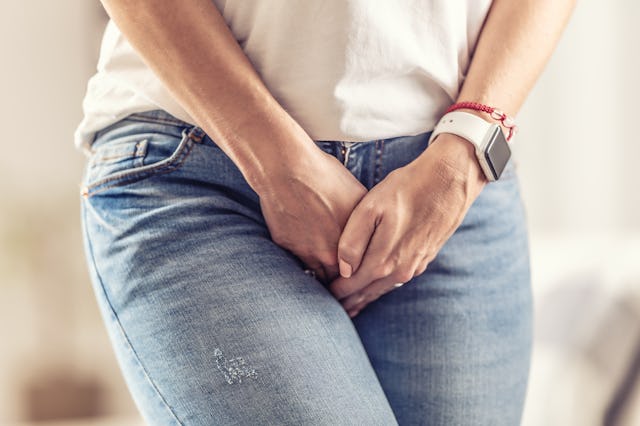Why Does My Urge to Pee Intensify Once I See a Bathroom Door?
I have a lot of “pee triggers.” Turns out there is an actual term for what I’m experiencing.

I have a lot of “pee triggers.” The moment my car pulls into my garage, I have to pee. If I’m out and a friend asks me to join her in the bathroom — as we girls are apt to do — I suddenly have to pee. And if I hear my husband get up in the middle of the night to go… guess who’s out of bed, next in line?
Turns out there is an actual term for what I’m experiencing. It’s called latchkey incontinence, a phenomenon where people feel the need to urinate upon arriving home or hearing certain sounds. It’s that drop-my-purse-and-run feeling.
Marisa M. Clifton, MD, FACS, associate professor of urology at Johns Hopkins and chief medical officer at Johns Hopkins Bayview Medical Center, explained to me that latchkey incontinence — also sometimes called turnkey incontinence — is an overactive bladder. “It’s a constellation of symptoms. It’s not really a disease, but it’s simply the patient’s experience.” It can be urgency, frequency, and sometimes incontinence, where leakage occurs. Dr. Clifton notes that this is incredibly common in women, particularly as we age. Add it to the list of perks, eh?
Many of us mothers are used to postpartum leakage, but Clifton says it’s important to distinguish this from bladder incontinence. That situation where you cough or sneeze and then pee yourself? That is called stress urinary incontinence. With this condition, you are putting pressure on your bladder, causing it to leak. With latchkey, your bladder becomes irritated and squeezes when you don’t want it to. It’s important to determine which one you have since treatments are different.
Is there a mental component to latchkey incontinence?
“Absolutely,” says Clifton, “the brain and the body are so connected, and that’s why it happens when people are turning that key. I don’t like to say it’s a mental component, but rather it’s just the mind-body response.”
With that mind-body connection, there is the potential for the bladder to start squeezing. “So when people say ‘it’s all in your head,’ I strongly disagree with that. But I do think if you change the way you think, you can calm your bladder,” Clifton shares.
I spoke with Becky Clarkson, PhD, director of the Continence Research Center at the University of Pittsburgh, who participated in an NIH study using neuroimaging to explore the brain-bladder connection. The two-part study began with a urodynamic test: inserting a catheter into the bladder to measure pressure and assess muscle function. Next, participants were shown images of personal triggers, like their front doors or running kitchen water, to see if their bladders responded.
These were compared with reactions to neutral images, such as sofas or their living rooms. “We found that there was a difference in what was happening in the brain,” Clarkson said. Much like Pavlov’s dogs, the team believes this reflects a conditioned response.
How do you treat an overactive bladder?
For an overactive bladder, working with a pelvic floor therapist can help you learn to suppress the urge to urinate. Leakage doesn’t need to be present to seek treatment. Clifton explains that immediately rushing to the bathroom at the first urge can actually reinforce the problem. “That’s where a therapist trained in this area can help,” she says. “It allows people to overcome this bad habit.” Like two siblings conspiring for evil, your brain and bladder are doing the same!
For post- or perimenopausal women, vaginal estrogen can help with bladder tissue irritation. There’s medication, nerve stimulators, or even bladder Botox (and yes, that’s exactly what you think it is).
Dr. Clarkson and her team recently published another study focused on treatment. Participants practiced a mindfulness body scan while viewing the same triggering images, paired with low-level electrical brain stimulation. Each person completed four sessions. “We found it significantly reduced urgency and urgency-related leaks,” Clarkson said. “The results were comparable to those of medication and pelvic floor therapy.”
What about Kegels, you ask?
“Kegels are not the answer,” Clifton explains. “They are really only used for those who have stress incontinence. With an overactive bladder, they do more urge suppression therapy.”
When should someone seek treatment?
“The number one component to this is, how bothered by this are you?” Clifton asks. If you find it minimally invasive, consider starting with some behavioral changes, which might include:
- Eliminating Bladder Irritants — Think alcohol, certain medications (such as diuretics), artificial sweeteners, carbonation, and over-hydrating (looking at you, Stanley owners).
- Being mindful of the timing and amount of fluids when you’re drinking.
Would I like these triggers to have less control over me? For sure. Thankfully, I’m not peeing myself on the regular. But if you are, maybe it’s time to tell your doctor.